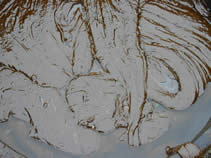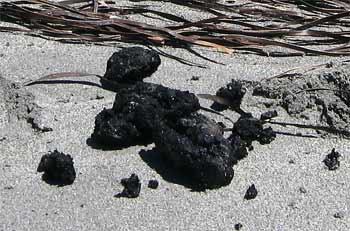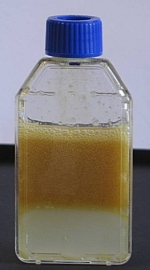L'altération des hydrocarbures à la surface de l'eau (3/4) - Processus physiques (en anglais)
Weathering of Oil on the Water Surface (3/4)
- Physical Processes -
6. Emulsification
In moderate to rough seas, most oils will take up water droplets and form water-in-oil emulsions under the turbulent action of waves on the sea surface. This process of emulsification significantly changes the properties and characteristics of spilled oil.
Due to the absorption of water, the volume of the pollutant may be increased by a factor of up to four times As the emulsion develops, the movement of the oil in the waves causes the droplets of water which have been taken up in the oil to become smaller and smaller, making the emulsion progressively more viscous and stable. This increase in viscosity can change originally liquid petroleum into a semi-solid material. Emulsified oil is no longer dispersible.
Experiment and Photo: Matthias Zech
As the amount of water absorbed increases, the density of the emulsion approaches that of sea water. Stable emulsions may contain as much as 70-80% water thus expanding the volume by three to five times the original volume of spilled material (Ocean Studies Board and Marine Board: 90). They are often semi-solid and have a strong red/brown, orange or yellow colour. They are highly persistent and may remain emulsified indefinitely. Less stable emulsions may separate out into oil and water if heated by sunlight under calm conditions or when stranded on shorelines.
The formation of water-in-oil emulsion reduces the rate of other weathering processes and is the main reason for the persistence of light and medium crude oils on the sea surface. However, emulsions do not always form. Water can be absorbed by the oil due to viscous forces, without forming an emulsion.
Chocolate mousse in the ocean

Photo: ITOPF
Tar balls on beaches
The chocolate mousse itself is subjected to physical and chemical breakdown of its components. After several weeks or months its residues form tar balls which may eventually end up being deposited on beaches. Tarballs usually consist of a solid outer crust of oxidised oil and sediment particles, surrounding a softer, less weathered interior (ITOPF 2002).

Photo: Government of Western Australia, Department for Planning and Infrastructure
Question: Why is the total volume of pollutant that needs to be recovered following an oil spill often greater than the initial volume of the oil spilt?


